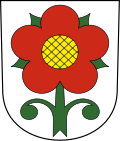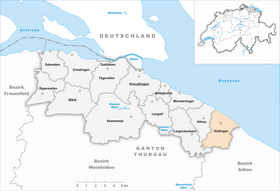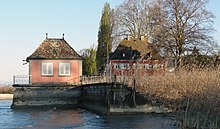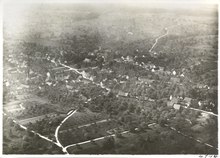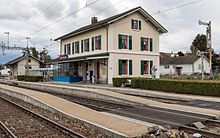Güttingen
| Güttingen | |
|---|---|
| State : |
|
| Canton : |
|
| District : | Kreuzlingen |
| BFS no. : | 4656 |
| Postal code : | 8594 |
| Coordinates : | 738 891 / 274 055 |
| Height : | 432 m above sea level M. |
| Height range : | 395–512 m above sea level M. |
| Area : | 9.54 km² |
| Residents: | 1591 (December 31, 2018) |
| Population density : | 167 inhabitants per km² |
| Website: | www.guettingen.ch |
|
Parish houses and parity church in Güttingen |
|
| Location of the municipality | |
Güttingen is a municipality and a town in the district of Kreuzlingen in the canton of Thurgau in Switzerland . Until 2002 Güttingen was a unified community .
geography
The clustered village of Güttingen, the core of which is about 1 kilometer from the shore of Lake Constance , is located on the Kreuzlingen - Romanshorn road connection . Güttingen borders the communities of Langrickenbach , Altnau , Kesswil and Sommeri . The Güttinger Forest belongs to the community .
history
The Stone Age bank settlements of Rotfarb / Moosburg from the 4th millennium BC are proven by finds. The early medieval settlement is evidenced by an Alemannic burial ground. The village was mentioned in 799 as Cutaningin and in 1155 as Guthingen . In 883, Emperor Karl the Fat transferred Güttingen to the St. Gallen monastery . In addition to the St. Gallen monastery, the Bishop of Constance in Güttingen was also wealthy. From 1159 to 1357 the barons of Güttingen acted as landlords and owners of the Frei vogtei Güttingen. In 1359 the bailiwick came to the Lords of Breitenlandenberg . In 1452 Heinrich Ehinger , Mayor of Konstanz, sold the Moosburg and Kachel castle to the Bishop in Konstanz for 700 guilders . Until 1798, the episcopal superior bailiff administered the lower court of Güttingen from the castle as the episcopal constance governor of Güttingen. In the Treaty of Meersburg of February 1804, Güttingen came into the possession of the young canton of Thurgau. In 1870 the administrations of the spatially identical local and municipal community of Güttingen were merged to form the unified community of Güttingen.
By 1275 at the latest there was a church in Güttingen; The church composition and collage were presumably with the Barons von Güttingen. During the Reformation , the community mostly adopted the new faith, but from 1554 to 1848 the Kreuzlingen monastery was in possession of the Kollatur. To this day the Church is in simultaneous use .
The branches of agriculture, shipping and fishing were replaced by cattle and dairy farming in the 19th century. In 1861 a dairy cooperative was established. At the beginning of the 20th century, field fruit growing, which was already documented for the 18th century, took the place of viticulture. The agricultural cooperative was founded in 1920. Neither the lake road built around 1840 nor the lake line opened in 1870 brought the village a direct economic boom. In 1835 a Turkish red dyeing factory was established in Güttingen, which was closed in 1939. From 1948 to 1974, chemical products were produced in Citosan. Around 1900 there was an embroidery and a ship embroidery. In addition to the intensive agriculture and a fruit trading company, medium-sized commercial and industrial companies such as the Kolb machine factory and the Naegeli metal goods factory offered some jobs in the first and second economic sectors in the late 20th century . In 1967 the Federal Test Farm for Fruit Growing Güttingen was opened.
coat of arms
Blazon : In white a red rose with a yellow clump , green calyx, stem and two leaves.
The community of Güttingen has taken over the coat of arms of the barons of Güttingen , who died out at the end of the 14th century, in a new drawing.
population
 |
| year | 1850 | 1900 | 1950 | 1970 | 1980 | 2000 | 2010 | 2018 |
| Residents | 385 | 412 | 558 | 739 | 1024 | 1308 | 1443 | 1591 |
Of the total of 1,591 inhabitants in the municipality of Güttingen in 2018, 318 or 19.10% were foreign nationals. 624 (39.2%) were Protestant Reformed and 462 (29.0%) were Roman Catholic.
Economy and Transport
In 2016, Güttingen offered 468 jobs (converted to full-time positions). 16.3% of these were employed in agriculture and forestry, 32.3% in industry, trade and construction and 51.5% in the service sector.
Güttingen has a train station on the Kreuzlingen – Romanshorn railway line and is served by the S3 and S8 lines of the St. Gallen S-Bahn .
Personalities
- Johann Ulrich Wagner (1819–?), Protestant clergyman in Geneva, who is said to have emigrated to New York after his release from the service
Attractions
- St. Stephen's Parity Church , built in 1431, tower raised around 1840
- Moosburg Castle (on the lakeshore between Güttingen and Kesswil), classicist villa built around 1850 from the stones of the former Moosburg Castle (private property)
Web links
Individual evidence
- ↑ Permanent and non-permanent resident population by year, canton, district, municipality, population type and gender (permanent resident population). In: bfs. admin.ch . Federal Statistical Office (FSO), August 31, 2019, accessed on December 22, 2019 .
- ↑ a b Thurgau in figures 2019 . On the website of the Statistical Office of the Canton of Thurgau (PDF file; 1.8 MB), accessed on April 28, 2020.
- ↑ a b Localities and their resident population. Edition 2019 . On the website of the Statistical Office of the Canton of Thurgau (Excel table; 0.1 MB), accessed on April 28, 2020.
- ↑ a b c municipal coat of arms . On the website of the State Archives of the Canton of Thurgau, accessed on December 8, 2019
-
↑ a b c d e f Verena Rothenbühler: Güttingen. In: Historical Lexicon of Switzerland .
These sections are largely based on the entry in the Historical Lexicon of Switzerland (HLS), which, according to the HLS's usage information, is under the Creative Commons license - Attribution - Share under the same conditions 4.0 International (CC BY-SA 4.0). - ^ A b c Hansueli Müller, Hans Litscher: Güttingen Thurgau . Stories, documents and pictures of bygone times. Ed .: on behalf of the community for the 1200 year celebration. 1999.
- ↑ a b Population development of the municipalities. Canton Thurgau, 1850–2000 and resident population of the municipalities and change from the previous year. Canton of Thurgau, 1990–2018. On the website of the Statistical Office of the Canton of Thurgau (Excel tables; 0.1 MB each), accessed on April 28, 2020.
- ↑ Satellite image
